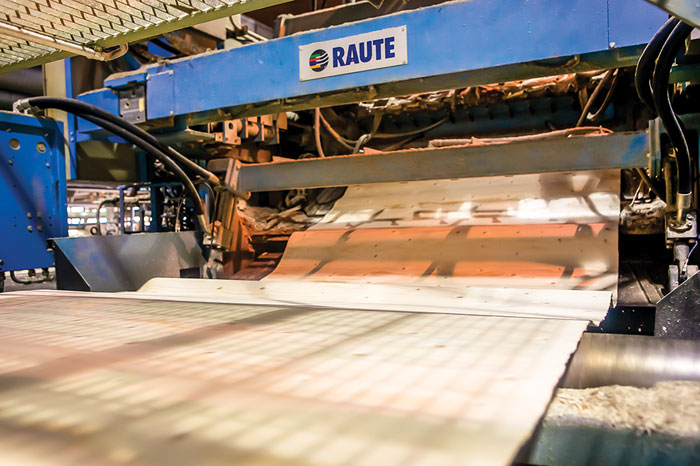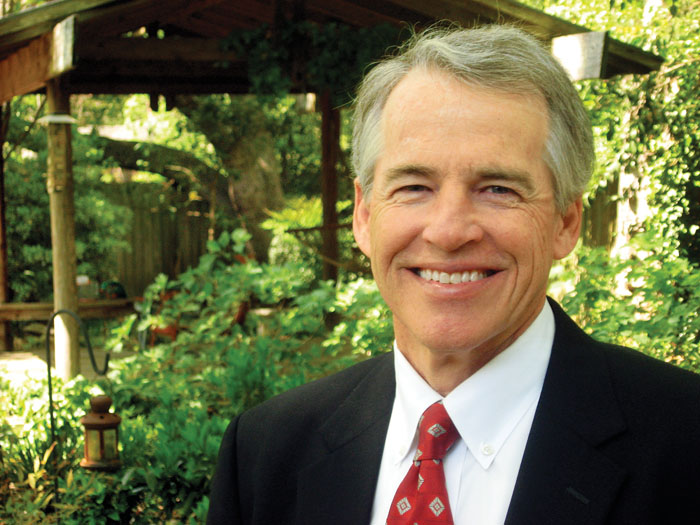
by Web Editor | Feb 21, 2014 | Supply Lines
Plywood Mills Eye Modernizations
Modernizations are a rapidly expanding trend in the plywood manufacturing business. “Companies have increasingly become more cost-aware, and therefore interested in improving their present machinery through modernizations as an alternative to new investments,” comments Petri Lakka, Group Vice President of Raute Technology Services.
At Raute, the growing interest around modernization projects has been earmarked. “Today customers want different options for their investments—some focus on acquiring new assets, but some are looking for cost-efficient modernizations for their production lines. Peeling line modernizations have been and still are the largest section of all modernization projects; modernizing a peeling line tends to be more cost-efficient than purchasing a brand new line,” explains Jussi Puranen, Technology Manager at Raute Finland.
In North America, the focus with peeling line modernizations tends to be on improving the quality and thickness tolerance of veneer, with increasing automation and better usability. “The ability to raise the level of automation is very important to our North American customers, where labor costs are high,” Puranen explains.
The challenge with peeling line modernizations is that it requires an understanding of the total process of veneer, plywood and LVL manufacturing. Raute’s advantage is its process expertise, offering lifespan services for a variety of demands.
A growing number of small service and machine manufacturers have entered the plywood markets, but Puranen sees Raute as able to respond to the tightening competition. “We have inextricably linked equipment manufacturing, sales and services to support our customers.”
Puranen sees modernizations moving from hydraulic solutions towards electric solutions. In addition, the growing demand of peeling line modernizations requires acceleration of the processes.
As of now, the modernization supply chains in this industry are mainly designed for bigger projects, but Puranen predicts a shift towards modernizing of smaller components as well. “We have to be extremely precise in everything we do, and to handle things quickly with minimum bureaucracy. Raute is ready to take on this challenge.”
(Article submitted by Raute)
RELATED ARTICLES
RAUTE TO MOVE LOCATIONS FOR CHINESE OPERATIONS
RAUTE GAINS PANEL REPAIR ORDERS
NEW PLYWOOD MILL GOES WITH RAUTE
The monthly Panel World Industry Newsletter reaches over 3,000 who represent primary panel production operations.
Panel World is delivered six times per year to North American and international professionals, who represent primary panel production operations. Subscriptions are FREE to qualified individuals.
Complete the online form so we can direct you to the appropriate Sales Representative. Contact us today!

by Web Editor | Feb 21, 2014 | Taking Stock
Story by Rich Donnell,
Editor-in-Chief
Pages 13-19 of this issue preview the upcoming Panel & Engineered Lumber International Conference & Expo, which will be held March 20-21 in Atlanta, Ga. at the Omni Hotel. This will be the fourth PELICE hosted by Panel World magazine for the structural and non-structural wood products industries.
In addition to 35 individual session speakers, the conference includes 10 keynote speakers who will address the entire attendance. PELICE has always handled its keynote general sessions differently than most functions. There will be three general sessions over the two-day conference, each with three to four keynoters. Most meetings I attend have one and maybe two primary keynoters. Also, PELICE only allows its keynoters approximately 20 minutes of speaking time, along with some Q&A. Our philosophy is you should be able to say what you want to say in 20 minutes, and if anybody in the audience wants more of your time, they can approach you afterward.
You can’t help but be impressed with the experience of many of our keynoters. The first morning, for example, includes two of my all-time favorites from our industry, one from the plywood side and the other from composite board.
Joe Andrews, general manager of Richmond Plywood in British Columbia, may win the award for the best title of a talk: “How 300 Men Shared a Dream: And How I Manage the Company They Turned into a World-Class Plywood Mill.” Richply as many of you know is a cooperative.
Andrews, from Bend, Ore., began working at age 16 at Jefferson Plywood in Madras, Ore. His father was a partner in the operation. Andrews went from the green chain to the dryers, to the spreaders, to resin and glue manufacturing to sales, and his final job there was wielding a cutting torch to dismantle the plant. And then he was old enough to go to college.
Since receiving a degree in Finance and Forest Products at Oregon State University, Andrews has held various management positions at plants for Willamette Industries, Plum Creek Timber and McKenzie Forest Products.
Also speaking the first morning of PELICE is Kelly Shotbolt, president of Flakeboard Company Ltd. His speech is “Transitioning into a New Era of Composite Products,” which will focus on the shared view of Arauco and Flakeboard that despite capacity and import pressures, a focused acquisition and investment strategy will influence the production of furniture and related products back to North America.
Shotbolt has been the Flakeboard president since 1993, and began work there after he graduated from the University of New Brunswick in 1979. He led the company’s transition from a commodity producer of raw panels to an integrated manufacturer of decorative panels.
In 2006, he drove Flakeboard’s acquisition of Weyerhaeuser’s composite panel business; in 2012 he negotiated the sale of Flakeboard to Arauco; and most recently he led Flakeboard’s acquisition of SierraPine’s Western composite board plants.
These are the caliber of speakers you will find at PELICE.
![BC Mills Under Dust Inspection]()
by Web Editor | Jan 8, 2014 | Update
WorkSafeBC officers have begun another round of inspections as part of the ongoing combustible dust initiative to focus sawmills and other wood processors on keeping work sites safe.
During the inspections WorkSafeBC officers examine dust accumulation; ventilation and dust collection systems; inspections and preventative maintenance of machinery and equipment with potential points of ignition; as well as ensure that operating locations have a plan to achieve effective and sustainable compliance going forward.
The combustible dust inspections began in late April 2012 following a directive order to all BC. sawmills to conduct a risk assessment for combustible wood dust and implement a combustible dust control program. All operational sawmills inspected in the first phase complied with the directive order. In July 2012, inspections were expanded to include other wood manufacturing operations that could produce combustible dust. In fall 2012, WorkSafeBC officers re-inspected all sawmills to further evaluate industry’s ongoing efforts to manage combustible dust.
The wood dust program began soon after explosions at two BC sawmills killed four in early 2012.

by Web Editor | Jan 3, 2014 | Taking Stock
Story by Rich Donnell,
Editor-in-Chief
I have been wearing my “chairman” hat as much as my “editor” hat lately as we make preparations for the 2014 Panel & Engineered Lumber International Conference & Expo (PELICE), which will be held March 20-21 at the Omni Hotel at CNN Center in downtown Atlanta, Ga.
I serve as co-chairman of PELICE, which I’m proud to say has withstood the test of time. Held in even-numbered years, this will be the fourth PELICE. The first one in 2008 was held in the middle of the great recession; the second one in 2010 was held when we were still in the great recession; the third one in 2012 was held as we were barely transitioning out of the recession and into what we hoped would be (and which indeed turned out to be) better times.
I can’t say thank-you enough to the exhibitors and attendees who participated in those first three events, despite the drag of the economy. The exhibitors understood that even during dismal times, it’s important to be a player and introduce new technologies. And the attendees understood that no matter the price of panels, there are always more efficiencies to be found in the operation of the mill. Perhaps that is why our first three events were still successful even in tough times. Our post-event surveys have always revealed that nearly 100% of attendees left PELICE with new information that could improve their operations. Isn’t that what it’s all about?
So now we come to the 2014 PELICE, which as I write this is all but sold out as far as exhibitor space—the earliest sell-out we’ve had yet. Now our attentions and those of the exhibitors will focus on bringing in the attendees from the structural and non-structural wood products operations.
One of the main things I like about PELICE is that it convenes people from the plywood, OSB, MDF, particleboard and engineered wood products sectors. I attend many association meetings that emphasize one of those areas, and these are great events. But I think the “big picture” environment that PELICE offers is beneficial to everyone, while at the same time providing seminars that specifically can enhance an operation in any of these panel groups.
Elsewhere in this issue we’ve announced our first wave of speakers and moderators for 2014 PELICE. You can visit pelice-expo.com and view the specific timeline agenda, which will also appear in the March issue of Panel World. You can also register right now on pelice-expo.com. I’m happy to report that the registration cost remains the same as it was when we started up in 2008.
And keep in mind, immediately preceding PELICE is our Bioenergy Fuels & Products Conference & Expo on March 18-19 also at the Omni Hotel. Many exhibitor companies and attendees participate in both the Bioenergy and PELICE events.
Here’s to a spirited 2014 PELICE, and the best of times all year long.
![BC Mills Under Dust Inspection]()
by Web Editor | Jan 3, 2014 | Update
Plum Creek Timber Co., Inc. has signed a $1.1 billion agreement to acquire approximately 501,000 acres of industrial timberlands, associated wind and mineral assets, and an interest in approximately 109,000 acres of high-value rural and development-quality lands from MeadWestvaco Corp.
Specifically, Plum Creek has agreed to acquire 501,000 acres of industrial timberlands in Alabama, Georgia, South Carolina, Virginia and West Virginia for $869 million; an investment in joint ventures consisting of 109,000 acres of high-value rural lands and development-quality lands near Charleston, SC for $152 million; subsurface rights, mineral rights and wind power assets associated with the timberlands for $65 million.
Rick Holley, Plum Creek CEO, comments, “These timberlands have a long history of excellent forest management. The high stocking levels and older age of the timberlands make them particularly attractive. These assets should integrate seamlessly into our existing timberland ownership in the Southeast and add to our presence in key markets.”
The timber harvest from the acquired lands is expected to average nearly 3 million tons annually over the next 10 years, growing Plum Creek’s total annual harvest more than 15% from recent levels.


